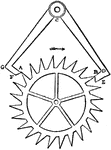Clipart tagged: ‘dead escapement’

Deadbeat Escapement
The deadbeat has a second face on the pallets, called the 'locking' face, with a curved surface concentric…

The deadbeat has a second face on the pallets, called the 'locking' face, with a curved surface concentric…